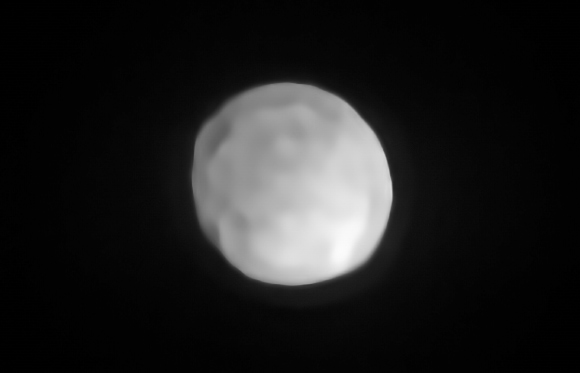Astronomers Measure Size and Shape of Main-Belt Asteroid Hygiea | Astronomy – Sci-News.com
Hygiea is the fourth largest main belt asteroid and the only known asteroid whose surface composition appears similar to that of the dwarf planet Ceres. Using the SPHERE instrument on ESO’s Very Large Telescope, astronomers have observed Hygiea in sufficiently high resolution to determine its shape and size and study its surface. The researchers have found that Hygiea is spherical, potentially taking the crown from Ceres as the smallest dwarf planet in the Solar System.

This image, taken by the SPHERE instrument on ESO’s Very Large Telescope, shows the main-belt asteroid Hygiea. Image credit: ESO / P. Vernazza et al / MISTRAL algorithm / ONERA / CNRS.
As an object in the main asteroid belt, Hygiea satisfies right away three of the four requirements to be classified as a dwarf planet: it orbits around the Sun, it is not a moon and, unlike a planet, it has not cleared the neighborhood around its orbit.
The final requirement is that it has enough mass for its own gravity to pull it into a roughly spherical shape. This is what the new SPHERE observations have now revealed about Hygiea.
“Thanks to the unique capability of the SPHERE instrument, we could resolve Hygiea’s shape, which turns out to be nearly spherical,” said Dr. Pierre Vernazza, a scientist in the Laboratoire d’Astrophysique de Marseille.
“Thanks to these images, Hygiea may be reclassified as a dwarf planet, so far the smallest in the Solar System.”
The team used the new data to constrain Hygiea’s size, putting its diameter at 270 miles (434 km). Pluto, the most famous of dwarf planets, has a diameter of 1,477 miles (2,377 km), while Ceres’ diameter is 588 miles (946 km) across.
Surprisingly, the observations also revealed that Hygiea lacks the very large impact crater that scientists expected to see on its surface.
Hygiea is the main member of one of the largest asteroid families, with close to 7,000 members that all originated from the same parent body.
Astronomers expected the event that led to the formation of this numerous family to have left a large, deep mark on Hygiea.
“This result came as a real surprise as we were expecting the presence of a large impact basin, as is the case on Vesta,” Dr. Vernazza said.
Although the astronomers observed Hygiea’s surface with 95% coverage, they could only identify two unambiguous craters.
“Neither of these two craters could have been caused by the impact that originated the Hygiea family of asteroids whose volume is comparable to that of a 62-mile (100 km) sized object. They are too small,” said Dr. Miroslav Brož, a researcher in the Astronomical Institute at the Charles University.
Using numerical simulations, the astronomers deduced that Hygiea’s spherical shape and large family of asteroids are likely the result of a major head-on collision with a large projectile of diameter between 47 and 93 miles (75-150 km).
Their simulations show this violent impact, thought to have occurred about 2 billion years ago, completely shattered the parent body.
Once the left-over pieces reassembled, they gave Hygiea its round shape and thousands of companion asteroids.
“Such a collision between two large bodies in the asteroid belt is unique in the last 3–4 billion years,” said Pavel Ševeček, a PhD student at the Charles University.
The team’s results appear in the journal Nature Astronomy.
_____
P. Vernazza et al. A basin-free spherical shape as an outcome of a giant impact on asteroid Hygiea. Nature Astronomy, published online October 28, 2019; doi: 10.1038/s41550-019-0915-8





